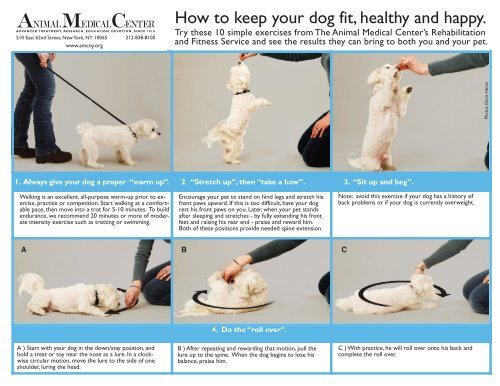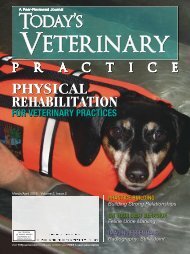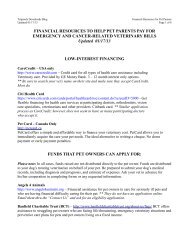How to keep your dog fit, healthy and happy. - Tripawds Downloads
How to keep your dog fit, healthy and happy. - Tripawds Downloads
How to keep your dog fit, healthy and happy. - Tripawds Downloads
Create successful ePaper yourself
Turn your PDF publications into a flip-book with our unique Google optimized e-Paper software.
<strong>How</strong> <strong>to</strong> <strong>keep</strong> <strong>your</strong> <strong>dog</strong> <strong>fit</strong>, <strong>healthy</strong> <strong>and</strong> <strong>happy</strong>.<br />
Try these 10 simple exercises from The Animal Medical Center’s Rehabilitation<br />
<strong>and</strong> Fitness Service <strong>and</strong> see the results they can bring <strong>to</strong> both you <strong>and</strong> <strong>your</strong> pet.<br />
Pho<strong>to</strong>s: Denis Horan<br />
1. Always give <strong>your</strong> <strong>dog</strong> a proper “warm up”. 2. “Stretch up”, then “take a bow”.<br />
Great for core conditioning. Using a <strong>healthy</strong> treat, lure<br />
the3. <strong>dog</strong>’s “Sit head up up<strong>and</strong> as far beg”. as it will go <strong>and</strong> hold that<br />
position for a few seconds.<br />
Note: avoid this exercise if <strong>your</strong> <strong>dog</strong> has a his<strong>to</strong>ry of<br />
back problems or if <strong>your</strong> <strong>dog</strong> is currently overweight.<br />
Walking is an excellent, all-purpose warm-up prior <strong>to</strong> exercise,<br />
practice or competition. Start walking at a comfortable<br />
pace, then move in<strong>to</strong> a trot for 5-10 minutes. To build<br />
endurance, we recommend 20 minutes or more of moderate<br />
intensity exercise such as trotting or swimming.<br />
Encourage <strong>your</strong> pet <strong>to</strong> st<strong>and</strong> on hind legs <strong>and</strong> stretch his<br />
front paws upward. If this is <strong>to</strong>o difficult, have <strong>your</strong> <strong>dog</strong><br />
rest his front paws on you. Later, when <strong>your</strong> pet st<strong>and</strong>s<br />
after sleeping <strong>and</strong> stretches - by fully extending his front<br />
feet <strong>and</strong> raising his rear end - praise <strong>and</strong> reward him.<br />
Both of these positions provide needed spine extension.<br />
A B C<br />
4. Do the “roll over”.<br />
A ) Start with <strong>your</strong> <strong>dog</strong> in the down/stay position, <strong>and</strong><br />
hold a treat or <strong>to</strong>y near the nose as a lure. In a clockwise<br />
circular motion, move the lure <strong>to</strong> the side of one<br />
shoulder, luring the head.<br />
B ) After repeating <strong>and</strong> rewarding that motion, pull the<br />
lure up <strong>to</strong> the spine. When the <strong>dog</strong> begins <strong>to</strong> lose his<br />
balance, praise him.<br />
C ) With practice, he will roll over on<strong>to</strong> his back <strong>and</strong><br />
complete the roll over.
5. Try some “paw power”. 6. Join in a “tug of war”. 7. “Rock on”!<br />
Give <strong>your</strong> <strong>dog</strong> a “High Five”! The <strong>dog</strong> will reach up with<br />
one paw. Repeat 2 <strong>to</strong> 3 times on each side.<br />
This movement exercises shoulders, front legs <strong>and</strong><br />
elbows.<br />
Encourage the <strong>dog</strong> <strong>to</strong> pull straight back—not side <strong>to</strong> side.<br />
A useful tip: hold the tug straight <strong>to</strong> the floor as this<br />
works the muscles in the front legs as well as the hind<br />
legs.<br />
Grab a couch cushion, rocking chair, air mattress or<br />
commercial "bosu"—anything you can rock by h<strong>and</strong>.<br />
St<strong>and</strong> the <strong>dog</strong> on whatever you’ve chosen <strong>and</strong> slowly<br />
rock. The <strong>dog</strong> will au<strong>to</strong>-matically shift his weight <strong>to</strong><br />
correct balance with every motion.<br />
8. Make <strong>your</strong> <strong>dog</strong> athletically “inclined”. 9. “St<strong>and</strong> on three legs”.<br />
10. Do the “<strong>happy</strong> butt scratch dance”.<br />
Get <strong>your</strong> pet <strong>to</strong> lift his front limbs from the ground by<br />
using a Physioball, going upstairs or even “dancing”. These<br />
exercises will strengthen the hind limbs. Repeat this<br />
exercise with the rear legs <strong>to</strong> strengthen the front limbs.<br />
Lift one of <strong>your</strong> pet's legs off the ground. If it’s the front<br />
leg, bring the leg forward. If it's the rear leg, lift it back<br />
wards. Support the leg lightly so <strong>your</strong> <strong>dog</strong> cannot use<br />
<strong>your</strong> grip <strong>to</strong> help support himself. This exercise helps <strong>to</strong><br />
improve weight bearing <strong>and</strong> strength.<br />
Vigorously scratch the <strong>to</strong>p of <strong>your</strong> <strong>dog</strong>’s rear end. Most<br />
<strong>dog</strong>s find this stimulating <strong>and</strong> will “dance” from side <strong>to</strong><br />
side with the rear legs, shifting their weight <strong>and</strong><br />
strengthening these muscles.<br />
The contents of this article are for informational <strong>and</strong> educational purposes only. This article is not intended <strong>to</strong> substitute for professional veterinary advice, diagnosis, or treatment.<br />
The responsibility for assuring the health of animals remains with treating veterinarians, <strong>and</strong> must be based upon their professional experience, knowledge of the patient, <strong>and</strong> communication with the pet owner.<br />
The Animal Medical Center assumes no liability or responsibility for any diagnosis or treatment made in reliance of this article.
The AMC’s<br />
Rehabilitation <strong>and</strong><br />
Fitness Service<br />
The only facility of its kind in<br />
NewYork City<br />
Our new, state-of-the-art suite for companion animals <strong>and</strong> exotics has<br />
been fully equipped with underwater- <strong>and</strong> l<strong>and</strong>-based treadmills, a<br />
hydrotherapy tub <strong>and</strong> much, much more. In addition, our staff will be<br />
<strong>happy</strong> <strong>to</strong> formulate a specialized program for <strong>your</strong> pet, including diet <strong>and</strong><br />
home exercise recommendations.<br />
These services can be particularly beneficial <strong>to</strong> pets that are:<br />
• Elderly<br />
• Arthritic<br />
• Suffering from endocrine diseases such as diabetes, Cushings,<br />
hypothyroid, <strong>and</strong> others<br />
• Neurologically impaired<br />
Contact Information<br />
To set up an appointment at<br />
The Animal Medical Center,<br />
call (212) 838-7053, from 9AM <strong>to</strong> 10PM,<br />
seven days a week.<br />
To speak directly <strong>to</strong><br />
The AMC’s Rehabilitation <strong>and</strong> Fitness Service,<br />
call (212) 329-8610.<br />
In case of emergency, bring <strong>your</strong> pet directly<br />
<strong>to</strong> The Animal Medical Center.<br />
Your pet will be examined <strong>and</strong> cared for by<br />
one of our veterinarians.<br />
If you are a veterinarian making a referral, call<br />
The Referral Office at<br />
(212) 329-8890 or (212) 329-8758.<br />
For general information, call (212) 838-8100<br />
or log on <strong>to</strong>: www.amcny.org<br />
• Overweight<br />
• Athletic<br />
To speak directly <strong>to</strong> The Rehabilitation <strong>and</strong> Fitness Service or <strong>to</strong> make an<br />
appointment, call (212) 329-8610.<br />
THE ANIMAL MEDICAL CENTER<br />
510 East 62nd Street<br />
New York, NY 10065






